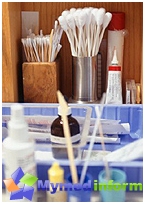What are gynecological procedures that often cause fear of women?
Content
To the gynecologist appeal in the following cases:
Inspection begins with conversation
At the entrance to the office, the doctor determines the characteristics of the patient's figure, the amount of hair on the body, which can tell about the hormonal status of the body or its violation. Specifying general questions about working conditions, sexual relations, partner, experience and character nature - the doctor chooses diagnostic methods. That is why it is important to clearly formulate the purpose of the visit - a planned inspection, postpartum, analyzes for infections and T.D.
The following procedures may be carried out in the gynecological office:
 Two-handed research. The position, state of the uterus, uterine pipes, ovaries is determined. This is diagnosed by the Mioma of the uterus, inflammation of appendages, cysts of ovarian, ordinary or ectopic pregnancy. For more detailed analysis, direction on ultrasound.
Two-handed research. The position, state of the uterus, uterine pipes, ovaries is determined. This is diagnosed by the Mioma of the uterus, inflammation of appendages, cysts of ovarian, ordinary or ectopic pregnancy. For more detailed analysis, direction on ultrasound.
Inspection in mirrors. The doctor examines the external genital organs: the walls of the vagina, the cervix.
Smear on flora. Special spoonful doctor «scratches» Separated mucous membrane of the cervical cervical cervix, vagina, urethra and affects glass. In the laboratory it is possible to identify under the microscope of the inflammatory process (by the number of leukocytes - white blood cells), hidden infections (candidiasis, bacterial vaginosis).
Analysis on infection held in specialized centers. The method of polymerase chain reaction is examined by material from the cervical cervix (closed using mini-rod, on whose bristles there are epithelium cells with bacteria living in them). Analysis is used to diagnose herpes, chlamydia, mycoplasmosis, ureaplasmosis, papillomatosis. Analyzes for an infection is recommended immediately after menstruation: the first days after «Critical days» The best time to diagnose and carry out many studies. During menstruation, the inspection is not recommended.
Attention! After treatment with antibiotics, 1-2 months must pass, since drugs affect the vaginal microflora, and the results of the staging of the smear may turn out to be inaccurate.
Linked immunosorbent assay Determines the level of antibodies to a specific infection and allows you to accurately establish, in what form - acute or chronic - disease occurs.
Sowing on flora / sensitivity Antibiotics are prescribed with frequently repeated ailments. The material from the vagina or cervical canal is placed in the nutrient medium, bacteria are grown on it. According to the study «Harvest» The most effective antibacterial drugs are selected.
Colposcopy. Inspection of the cervix under the microscope allows you to detect erosion, leukoplaki, papillomatosis, tumor changes. If necessary, take a biopsy (small piece of fabric), sent to histological examination, which gives accurate information about the state of the cells in «Problem» place.
Ultrasound. Auxiliary diagnostics that helps collect data on the state of the mucous membrane of the uterus, size and arrangement of organs, clarify or refute the initial diagnosis made by hand. Outdoor (transabdominal) ultrasound is carried out through the abdomen (front abdominal wall) with a bladder filled with bladder.
At internal (Transvaginal) study when the device sensor in a one-time condom is introduced into the vagina, it is possible to detect adhesions, the state and size of the ovaries is determined, the amount of endometrium, lining the uterus, ripening and passing the egg. This study is contraindicated in late pregnancy, because it can provoke miscarriage.
Blood analysis. The cyclicity of monthly changes in the body of a woman is due to fluctuations in the level of hormones in the blood, which depends on the menstrual cycle. Analyzes are closed on certain days cycles. If hormonal violations were found in the results, then additional studies are carried out - computer tomography, skull radiography for collecting data on the state of the pituitary, regulating the production of hormones that control the reproductive system.
Medico-genetic studies Recommended by those women who are planning pregnancy or suffered miscarriage, underdeveloped pregnancy, the birth of children with deviations.
In diagnosing infertility, in addition to the level of hormones, investigate Patency of uterine pipes. The method of kimographic perturbation involves introducing in the uterus, pipes and the abdominal cavity of air or gas, after which the reductions in the uterine pipes are graphically recorded. Additionally required hysterosalpingography - A special substance is admitted to the uterus, after which the X-ray is made.
Laparoscopy. Inside the organs introduced the camcorder through a small puncture in the abdominal cavity. It is carried out in the diagnosis of infertility, ectopic pregnancy, appendicitis.
Hysteroscopy. The manipulator with the camcorder is carried out to identify intrauterine pathologies. Biopsy takes a suspicious site.
Analysis on cytology - This is the scraping of cells from the wall of the cervix for the study. It is carried out for timely detection of modified cells: the cervical cancer is one of the most common causes of women's mortality.
No analysis shows a complete picture of the state of health or the pathology of a woman, and therefore more often a gynecologist prescribes several analyzes at the same time. The information obtained with their help certainly helps to make a diagnosis.
When planning a child, it is necessary to undergo a full-fledged survey at the gynecologist and other specialists (therapist, Laura, Okulist, etc.).
Survey on the chair It is carried out for the initial assessment of the state of the uterus, taking smears on the flora and hidden infections (if they are not commissioned early). Emergency inspection is carried out according to the testimony - check on the opening of the cervix, bleeding and so. Further inspections are more often held on the couch. Instrumental studies include.
Tazometer. Determines whether the course of labor is possible through the natural generic paths, is there any narrowing of the pelvis, injuries, or need cesarean section.
Tape measure. The height of the bottom of the uterus, the abdominal circle. The data is necessary for making a picture of the development of the fetus, whether the size of the pregnancy is true.
Cardiotocography (CTG). Sensors on the stomach of pregnant travelers capture uterine cuts, as well as heart activities and fetal movements. Data is recorded in the form of a curve, it is concluded on its indicators about the state of the child's health, possible oxygen starvation, reduced cardiac activity and T.D.
During 16-21 weeks of pregnancy, it is recommended to conduct Analysis on alpha fetoprotein - Blood test, which reflects the development of the nervous system of the fetus.
TO Study of spindle water Resort when suspected any deviations (for example, genetic) in the body of the child.
Also included in the competence of the doctor - whether it is one of the composition, whether there are no seals, tumors, discharges. For a more detailed study, the gynecologist will send the patient on the ultrasound of the breast, to the mammologist. Planned inspection Mammologist spends in the first phase of menstruation.









